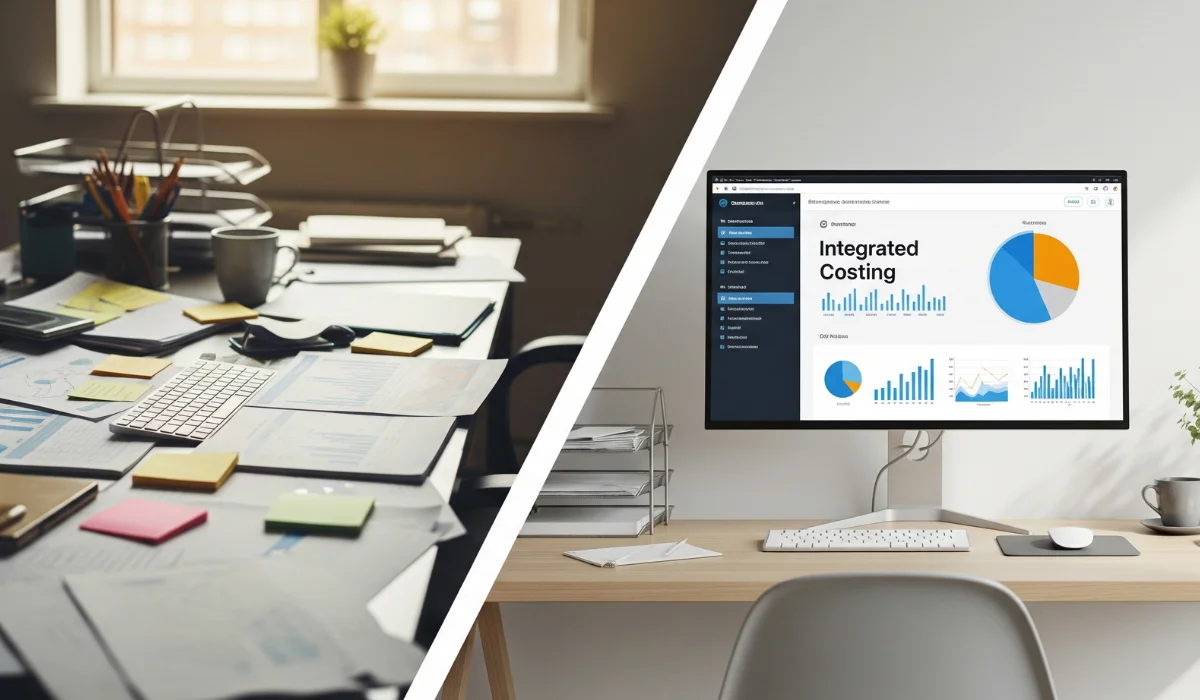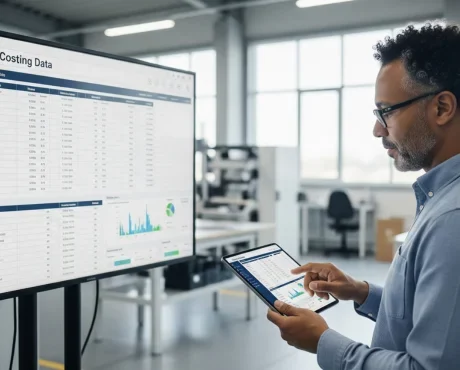Costing is a form of operational discipline. It often determines whether a company ends a quarter ahead or falls short of its targets. Yet, many manufacturers still rely on outdated systems that are too slow, too fragmented, and too unreliable to keep pace with today’s production demands.
Manufacturing today faces rising labor costs, volatile raw material prices, high demands for customization, and pressure to remain lean. If a company doesn’t have a clear picture of what things cost, right now, it’s operating blind.
Digital costing tools go beyond typical software, they introduce a new way of managing costs. They represent a shift in how manufacturing leaders approach cost control, pricing strategy, and operational decision-making. This blog explains what digital costing tools are, why traditional methods fall short, and how modern tools provide manufacturers with a stronger foundation for competition.
The Old Way Is Broken: Why Traditional Costing Fails Today

Many companies still use spreadsheets or disconnected ERP modules to track costs. This approach may have been effective when production runs were lengthy, products were standardized, and cost fluctuations were infrequent. That’s no longer the case.
Modern production is dynamic. A single job could involve multiple suppliers, complex routing, machine downtime, design changes, and fluctuating energy rates. Trying to track all of that manually or days after it happened, creates two major problems:
- Delayed insight: If costs are calculated weekly or monthly, any issue such as overuse of materials or excessive machine time, is identified too late to be fixed.
- Inaccurate decision: They lack visibility into day-to-day production events, making it hard to respond quickly. They don’t update when a supplier raises prices or when labor costs exceed expectations. This disconnect leads to quoting errors, missed margin targets, and poor pricing decisions.
In short, the old way is reactive. It leaves managers solving problems after they’ve already become costly.
What Are Digital Costing Tools?
Digital costing tools integrate seamlessly with your existing systems such as ERP, MES, and supply chain software, and pull real-time data from across the entire operation. They track everything that contributes to the cost of a product or job: labor hours, machine usage, material consumption, subcontracted services, overhead, and even rework or waste.
These tools continuously update cost data as events happen. If a machine runs slower than expected or if more material is scrapped, that cost difference is reflected immediately. It enables manufacturers to see how each aspect of production impacts profit as it happens.
Some tools like Cost It RIght, Acumatica’s Manufacturing Edition, tie costing directly to the bill of materials (BOM), production schedules, and inventory systems. Others, such as Tset, specialize in detailed cost modeling that supports should-cost analysis and design-for-cost strategies.
The point is not just automation. It’s the ability to see the financial impact of operational decisions as they unfold.
Key Benefits of Digital Costing Tools in Manufacturing
a. Real-Time Cost Visibility
Instead of waiting for end-of-week reports, plant managers and finance teams can view costs in real time. The system monitors how expenses, both direct and indirect, change during production, from labor to energy consumption.
If a job is running over budget, they know today, not two weeks from now. That immediate feedback loop enables fast intervention, preventing small issues from becoming major cost overruns.
b. Greater Accuracy Across BOMs and Jobs
Costing tools are tightly linked to the actual bill of materials and routing steps. This ensures that every element contributing to cost, from materials and work centers to subcontracted processes, is tracked at the right level of detail.
Standard costing often hides complexity. Actual costing tools reveal it. If a custom job runs longer due to setup complexity, the system captures this deviation and associates it with the exact job or product variant.
This level of granularity is essential for manufacturers with product variations or custom work orders.
c. Automation of Tedious Costing Tasks
Relying on manual inputs for tracking cost differences slows down processes and increases the risk of errors. Digital tools automate these tasks. Employee time on tasks can be recorded instantly at the workstation using digital interfaces or kiosks.
Material use can be recorded via barcode scanning or IoT sensors. Overhead can be allocated based on real-time machine usage.
This automation not only reduces mistakes but frees up finance and operations staff to focus on analysis and improvement, rather than chasing down data.
d. Stronger Cost Control and Margin Protection
Digital costing provides early warnings when actual costs drift from targets. Whether it’s a batch of raw material that’s more expensive than expected or excessive rework due to quality issues, the system flags those deviations early.
This gives decision-makers time to adjust workflows, renegotiate supply contracts, or re-quote future jobs with greater accuracy.
It also supports better margin tracking at the job, product line, or customer level, providing leadership with clearer visibility into which areas of the business are performing well and which are not.
e. Faster, More Accurate Quoting
Accurate quoting depends on accurate costing. If a manufacturer consistently underestimates labor time or material costs, they risk losing money on every order. Digital costing tools reduce this risk by linking historical performance to new estimates.
Some systems allow quoting teams to simulate different cost scenarios such as changes in batch size, material grades, or shift schedules and immediately see the impact on pricing. This improves win rates while protecting margins.
f. Integrated Decision-Making Across Teams
When costing data is accessible in real time, it brings departments together. Finance, operations, engineering, and procurement work from the same set of numbers. There’s no more debate over “whose data is right” or whether the financial report is outdated.
This alignment supports better decisions across the board, from design changes and production planning to supplier negotiations.
For example, engineering might use costing data to select lower-cost materials that meet performance specs. Procurement can use actual usage rates to drive better volume discounts. Instead of relying on historical data, finance leaders can revise forecasts using current activity from the shop floor.
g. Innovation Without the Guesswork
Product development often involves trade-offs. Better materials might increase performance but raise costs. A more complex design might increase labor time. Digital costing tools allow teams to model these changes and predict their impact before production begins.
Some tools support “should-cost” analysis, where design and procurement teams compare actual costs to target benchmarks. Others integrate with digital twins or simulation software, allowing manufacturers to evaluate cost scenarios alongside performance simulations.
This enables smarter innovation, without relying on gut instinct or backward-looking averages.
Choosing the Right Tool: What to Look For
Not every tool is right for every shop. Some manufacturers need a fully integrated ERP system with embedded costing features. Others may prefer a lightweight, stand-alone tool that connects to existing platforms. So, how to find the best costing tool.
Here are key factors to consider:
- BOM and routing support: The system should accurately model how your products are built, including labor, machines, tools, and overhead. Job costing capabilities are essential for custom manufacturing, particularly in job shops or make-to-order businesses.
- Real-time integration: Look for tools that connect to your shop floor data, not just your accounting software.
- Cloud vs. on-prem: Cloud-based systems offer easier updates and remote access, but may raise data security questions for some firms.
- Scalability: Your tool should grow with your business, supporting multiple locations, currencies, or business units if needed.
- User experience: If it’s hard to use, nobody will use it. Make sure the interface is practical for both finance and operations teams.
Conclusion
In manufacturing, guessing the cost of a product or learning it after the fact, is no longer good enough. With rising input costs, customized products, and tight delivery schedules, profitability depends on knowing your numbers at all times.
Digital costing tools give manufacturers the clarity they need. They replace guesswork with data, delays with real-time insight, and reactivity with control.
If you’re still relying on spreadsheets or outdated systems, now is the time to rethink how you manage costs. Because in modern manufacturing, every decision is a cost decision and the best ones are made with accurate, up-to-the-minute data.






